
The Masked Marvel (1943) is a 12-chapter film serial created by Republic Pictures, who produced many other well known serials. It was Republic's thirty-first serial, of the sixty-six they produced.

Radar Men from the Moon is a 1952 Republic Pictures' 12-chapter movie serial, the first Commando Cody serial starring newcomer George Wallace as Cody, Aline Towne as his sidekick Joan Gilbert, and serial veteran Roy Barcroft as the evil Retik, the Ruler of the Moon. The director was Fred C. Brannon, with a screenplay by Ronald Davidson, and special effects by the Lydecker brothers. This serial recycles the flying sequences from Republic's earlier 1949 serial King of the Rocket Men. It was later released by Republic in 1966 as the 100-minute television film Retik the Moon Menace.

Zombies of the Stratosphere is a 1952 black and white Republic Studios serial directed by Fred C. Brannon, with a screenplay by Ronald Davidson, and special effects by Republic's Lydecker brothers. It was intended to be Republic's second serial featuring "new hero" Commando Cody and the third 12-chapter serial featuring the rocket-powered flying jacket and helmet introduced in King of the Rocket Men (1949). Instead, for reasons unknown, the hero was renamed "Larry Martin", who must prevent Martian invaders from using a hydrogen bomb to blow Earth out of its orbit, so that the Martians can move a dying Mars into a much closer orbital position to the Sun. As in Radar Men from the Moon, much of the screen time for each of the dozen chapters is spent on fistfights and car chases between the heroes and a gang of earthly crooks hired by renegade scientist Dr. Harding and his extraterrestrial colleague Marex to steal and stockpile the Atomic supplies needed for construction of the H-bomb.

Ace Drummond is a Universal Pictures 1936 film serial based on the comic strip "Ace Drummond" written by Captain Eddie Rickenbacker and drawn by Clayton Knight. The serial's cast features John King, Jean Rogers, Noah Beery Jr. and Jackie Morrow, with Lon Chaney Jr. in a supporting role.

Mysterious Doctor Satan is a 1940 American film serial directed by William Witney and John English. Produced by Republic Pictures, the serial stars Edward Ciannelli, Robert Wilcox, William Newell, C. Montague Shaw, Ella Neal, and Dorothy Herbert. The title of the serial is derived from that of its chief villain.
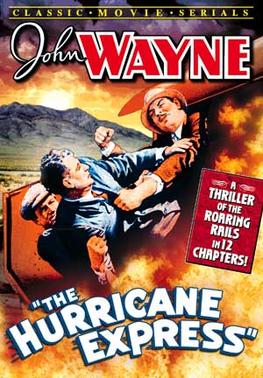
The Hurricane Express is a 1932 American Pre-Code 12-chapter Mascot Pictures film serial. Written by Colbert Clark, Barney Sarecky, Wyndham Gittens, George Morgan, and J.P. McGowan, the serial was directed by Armand Schaeffer and J.P. McGowan and produced by Nat Levine. The Hurricane Express stars John Wayne as aircraft pilot Larry Baker. Wayne goes after a mystery villain named "The Wrecker", who was responsible for a train crash that killed Baker's father.
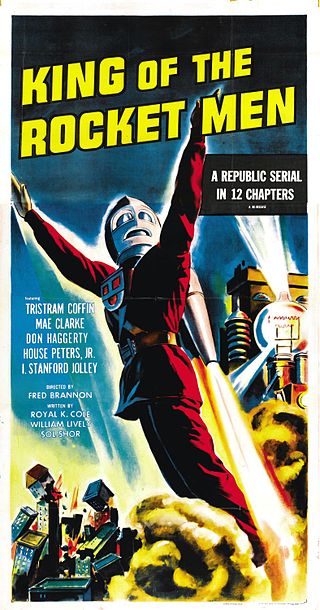
King of the Rocket Men is a 1949 12-chapter movie serial from Republic Pictures, produced by Franklin Adreon, directed Fred C. Brannon, that stars Tristram Coffin, Mae Clarke, Don Haggerty, House Peters, Jr., James Craven, and I. Stanford Jolley.

Flying Disc Man from Mars is a 1950 Republic Pictures 12-chapter black-and-white science fiction adventure film serial, produced by Franklin Adreon, directed by Fred C. Brannon, that stars Walter Reed, Lois Collier, Gregory Gaye, James Craven, Harry Lauter, and Richard Irving. Disc Man is considered a weak example of the serial medium, even compared to other post-World War II serials. In 1958 Republic edited the serial's 167 minutes of footage into a 75-minute feature, released under the new title Missile Monsters.

Captain America is a 1944 Republic black-and-white 15-chapter serial film loosely based on the Timely Comics character Captain America. It was the last Republic serial made about a superhero. It also has the distinction of being the most expensive serial that Republic ever made. It stands as the first theatrical release connected to a Marvel character. The film was re-released in 1953 and it was released in Turkey in popular before the release of the original comics, Turkish Captain America films was also produced such as 1968 film Binbaşı Tayfun and 1973 film 3 Dev Adam. It was the first live-action rendition of a Marvel character before Captain America live action segmnet by Arthur Pierce of the 1966 television series The Marvel Super Heroes in 1966, and Spider-Man appeared in the Spidey Super Stories segment of the children's television series The Electric Company in 1974.
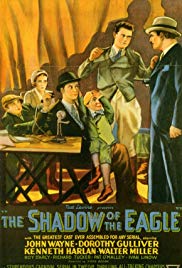
The Shadow of the Eagle is a 1932 American Pre-Code Mascot 12 episode film serial, directed by Ford Beebe and B. Reeves Eason and produced by Nat Levine. The film stars John Wayne in his first serial role. He would go on to star in two other serials for Mascot, The Hurricane Express (1932) and The Three Musketeers (1933). The Shadow of the Eagle is now in the public domain.
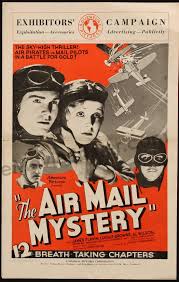
The Airmail Mystery is a 1932 Universal pre-Code movie serial directed by Ray Taylor, written by Ella O'Neill, starring James Flavin and Wheeler Oakman, and featuring Al Wilson doing the aerial stunts. The Airmail Mystery was Universal's first aviation serial that set the pattern for the aviation serials and feature films to follow. The film also marks the film debut of James Flavin. The Airmail Mystery is considered a lost film.

The Phantom of the Air is a 12-episode 1933 Pre-Code Universal film serial directed by Ray Taylor. The film stars Tom Tyler, who was cast most often in Westerns. Other actors include Gloria Shea, LeRoy Mason, Craig Reynolds and William Desmond.

Tailspin Tommy in the Great Air Mystery is a 12-episode 1935 Universal movie serial based on the Tailspin Tommy comic strip by Hal Forrest and starring Clark Williams, Jean Rogers and Noah Beery, Jr. The picture was the 96th of the 137 serials released by the studio.

Junior G-Men of the Air is a 1942 Universal film serial starring the Dead End Kids and the Little Tough Guys. A group of youthful flying enthusiasts join the "Junior G-Men" to help break up a planned attack on the United States.

Sky Raiders is a 12-episode 1941 Universal film serial. The serial was directed by Ford Beebe and Ray Taylor. Sky Raiders stars Donald Woods, Billy Halop, Robert Armstrong and Eduardo Ciannelli. Sky Raiders has little in common with Universal's other early-1940s espionage outings like Sea Raiders or Junior G-Men, although the serial is often lumped in together as if it is part of a series.

Adventures of the Flying Cadets is a 13-episode 1943 Universal film serial directed by Ray Taylor and Lewis D. Collins.
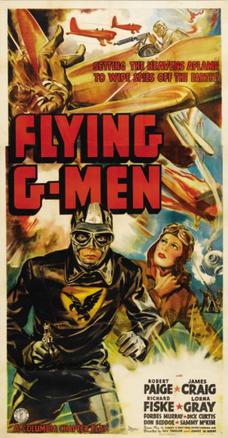
Flying G-Men is a 15-episode 1939 adventure film Film serial, directed by James W. Horne and Ray Taylor. The serial was the sixth of the 57 serials released by Columbia. Four "Flying G-Men" battle with enemy saboteurs intent on destroying American military defences.
Doctor Satan's Robot is a 1966 made for television film condensed from the original 1940 Mysterious Doctor Satan film serial named after its chief villain. Master criminal Doctor Satan has a nemesis, a masked mystery man, the "Copperhead", whose secret identity is Bob Wayne. Wearing a copper mask, Wayne is searching for justice and revenge on Satan for the death of his step-father. With Doctor Satan creating a mechanical robot that will terrorize the world, Wayne is determined to stop the criminal plans of the evil doctor.

Blackhawk is a 1952 American 15-chapter superhero movie serial from Columbia Pictures, based on the comic book Blackhawk, first published by Quality Comics, but later owned by competitor DC Comics. It was Columbia's forty-ninth serial. The one-sheet poster referred to the serial as The Miraculous Blackhawk: Freedom's Champion. The home video release added the tagline: "Fearless Champion of Freedom". The actual on-screen title is Blackhawk: Fearless Champion of Freedom.


















